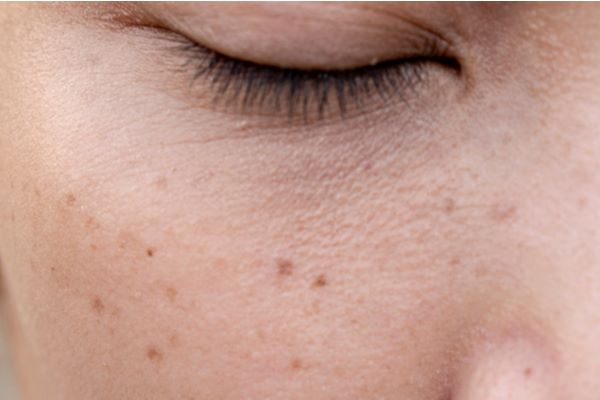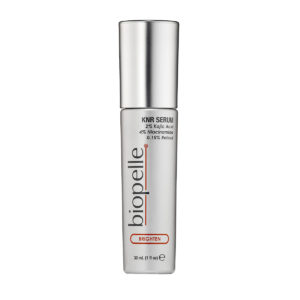Humans come in a full spectrum of shapes, sizes and shades. One factor responsible for creating all the beautiful diversity in skin tones, hair and eye color is melanin. Melanin helps protect our skin from harmful UV rays. When a body produces an excess of melanin as a form of protection, hyperpigmentation happens, and dark spots may appear on your body that were not there when you were younger. Hyperpigmentation can occur on your face, hands and decolletage.
While you may have been living with this discoloration for years, you don’t have to. There are ways to correct this skin concern and, further, help prevent more hyperpigmentation in the future. Let’s get geeky and talk a little about human biology.
What is Melanin?
Melanin is our skin’s protector and absorbent of light. It is produced by melanocyte cells in the basal layer of the epidermis. The more melanocytes you have, the more melanin your body produces. The more melanin, the darker your skin. Melanin not only guards your skin from UV damage, but it helps protect against aging as well. Over time, as your melanin works hard to protect you, unwanted pigmentation may form and result in uneven skin tone, dark circles, darker freckles, and age spots — all conditions known as hyperpigmentation.
What is Hyperpigmentation?
Hyperpigmentation is a darkening of parts of the skin beyond its natural color. As mentioned, it is caused when the skin produces an overabundance of melanin. This is a common skin condition that can be found in a few different forms including:
- Age spots (also known as sunspots): appear on skin after sun exposure and are common on face, hands, chest and arms (areas most exposed to the sun). These flat spots can be any shade of brown, grey or black.
- Dark circles under the eyes: due to increased accumulation of melanin around the eye
- Melasma: larger patches of darkened skin can appear on the forehead, face and stomach when a change in hormones occurs (such as pregnancy or taking birth control pills) or due to sun exposure or even genetics.
- Injury and inflammation spots: appear on face and neck after inflammation from injury occurs, e.g., acne, eczema, abrasion, burns, reactions to peels and other skin treatments
Certain medical conditions like Addison’s disease and hemochromatosis can cause hyperpigmentation in different areas of the body.
Melanin and Aging Skin
As most women over 50 can attest to, with increased age, skin can become thinner, can change tone and appear more translucent. The number of melanocytes decreases and the remaining melanocytes get larger in size as one ages. With advanced age, melanin may increase in the skin (dark spots) and decrease in hair (greying of the hair).
What Ingredients Can Reduce and Prevent Dark Spots?
Aging is a gift, but if you are wanting to look and feel a little younger, we don’t blame you. Thanks to skincare solutions, you can reduce visible signs of aging. There are cosmetic procedures like laser therapy, intense pulsed light, chemical peels and microdermabrasion that can help even out your skin. Be sure to consult with a board-certified dermatologist or NP because certain treatments can worsen hyperpigmentation.

KNR Serum
The following ingredients are touted to aid in removing, lightening, and/or preventing hyperpigmentation:
- Vitamin C
- Kojic acid
- Phytic acid
- Retinol
- Niacinamide
- BHA
- Grape seed extract
- Grapefruit extract
- Green tea extract
These active ingredients interaction with the melanin production process that causes hyperpigmentation at different key stages. For example, antioxidants help with prevention of the formation of hyperpigmentation whereas some of the acids remove surface-level hyperpigmentation that has already formed.
Along with using products aimed at reducing and preventing dark spots, it is essential to apply SPF 30 or higher broad-spectrum protection sunscreen every day (even rainy days). It can help prevent further darkening of existing spots as well.
Biopelle, a leader in advanced skincare, has product formulations that address every stage of the melanin production cycle, notably:
- XCP Brightening Serum provides antioxidant benefits with vitamin C (in the form of (L-Ascorbic acid), phytic acid, green tea extract and grape seed extract and helps improve the appearance of uneven skin tone and defend against free radicals.
- KNR Serum helps brighten skin tone and reduce the visible signs of hyperpigmentation with powerful ingredients like kojic acid and niacinamide. This power-packed serum is further fortified with retinol to help support cellular turnover, and in turn, reduce the appearance of discoloration that has already occurred in the skin for visible improvements in tone and texture.
Additionally, Biopelle’s entire line of Growth Factor skincare uses SCA Biorepair Technology which is clinically proven to help reduce visible signs of photodamage and hyperpigmentation.
Shop dermatologist-recommended hyperpigmentation products.
It is important to note that while hyperpigmentation is typically harmless, certain occurrences should be checked by a dermatologist because it can indicate a medical condition that needs attention. See a doctor if a spot is black, increasing in size and shape, has an unusual coloring or is bleeding.

